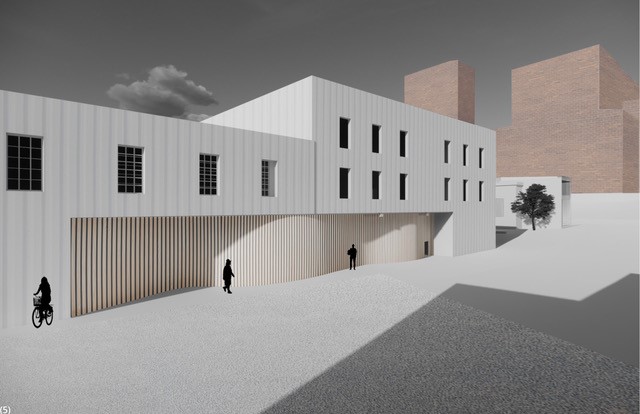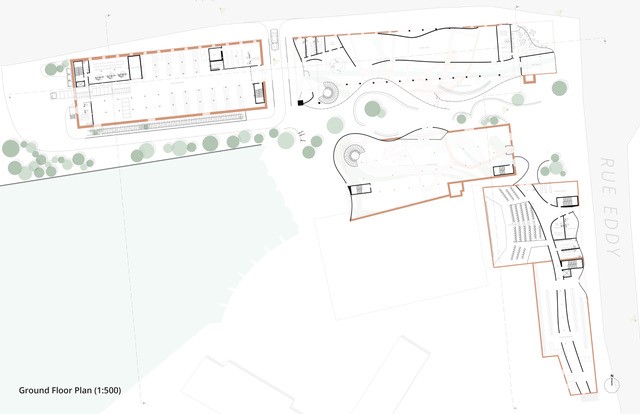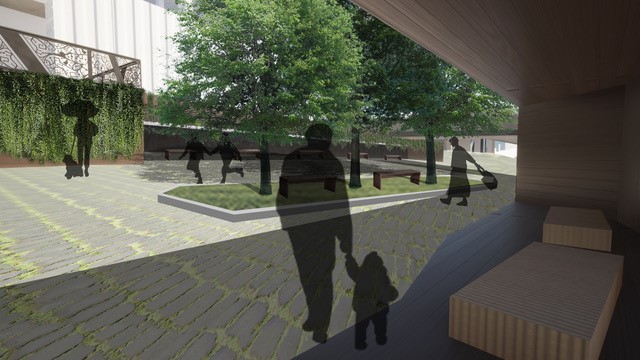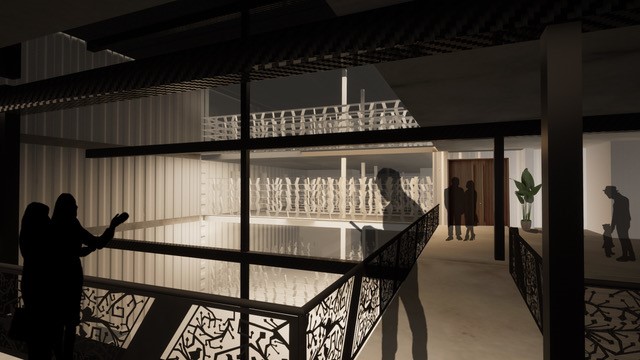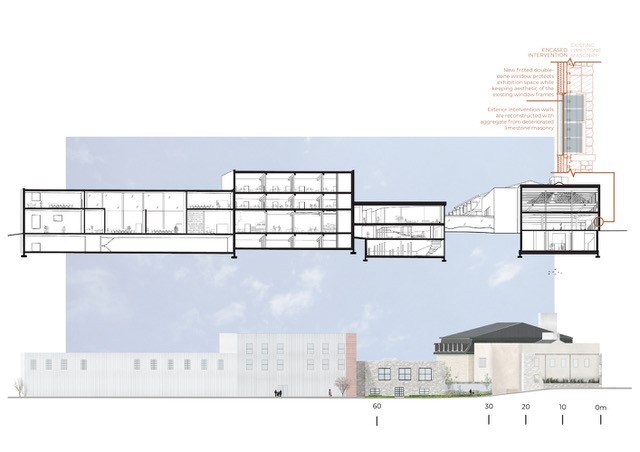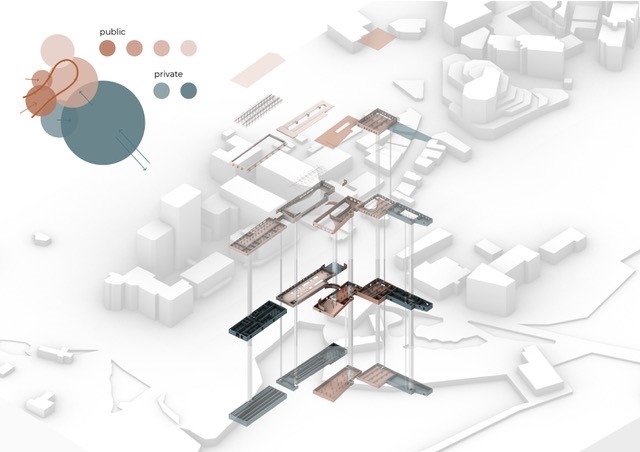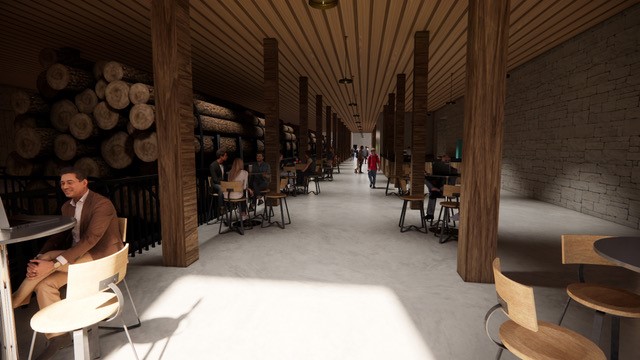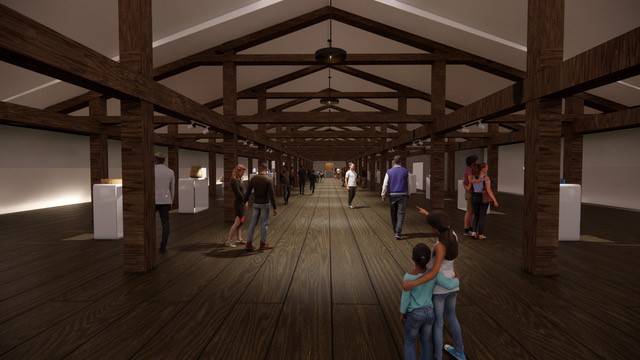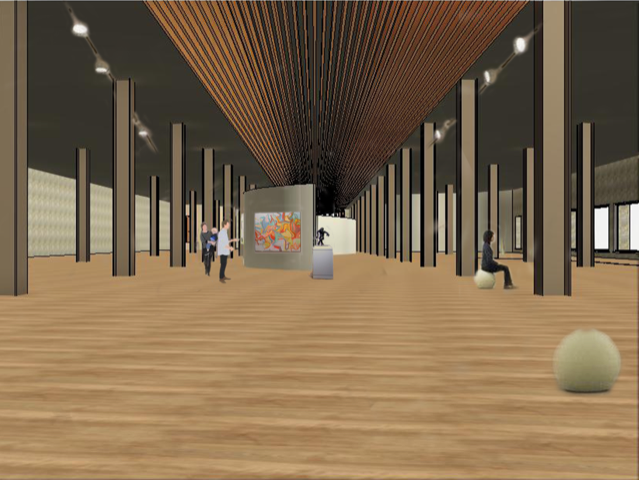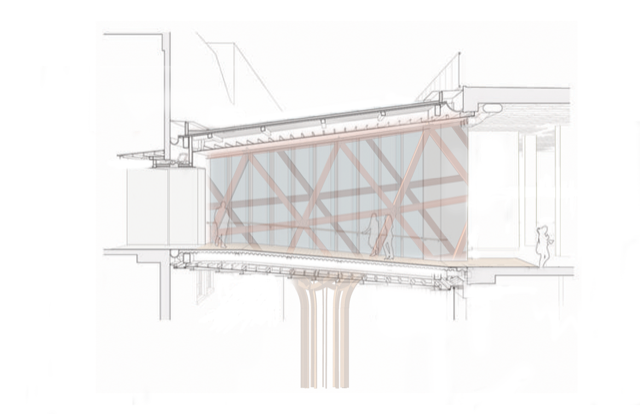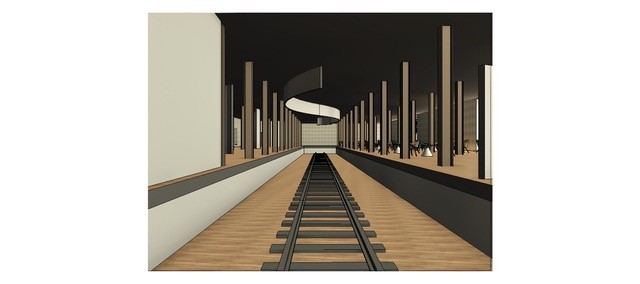E.B. Eddy Industrial Complex Adaptive Reuse Project – Outaouais Regional Museum
June 1, 2023
Six teams of students from the Azrieli School of Architecture and Urbanism (ASAU) designed proposals to transform the E.B. Eddy Industrial Complex space into the Outaouais Regional Museum.
When Lyette Fortin, an adjunct professor at ASAU, heard that the E.B. Eddy Industrial Complex was being considered as a potential location for the Outaouais Regional Museum, she contacted the Outaouais Regional Museum board of directors to see if they were interested in collaborating with her class. Over the winter term, 18 students in ARCS 3302 Conservation in Practice III Design Studio, had the opportunity to work with the board of directors and design proposals for the museum as an academic project.
The students were provided with information on the building, along with the mission, vision and program for the museum. The project was developed in three phases: understanding, planning and intervention (design). This involved building a site model and creating a 200-page report in phase A, to developing a “Parti” in phase B, to producing presentation panels and physical models in phase C to convey their designs with floor plans, elevations, renderings, landscape plans, etc.
Architects Mark Brandt, Catherine McBain and Chris Warden of Trace Architectures, and Roberto Campus at Figurr Architects participated in all phases of the project and provided invaluable feedback to the students.
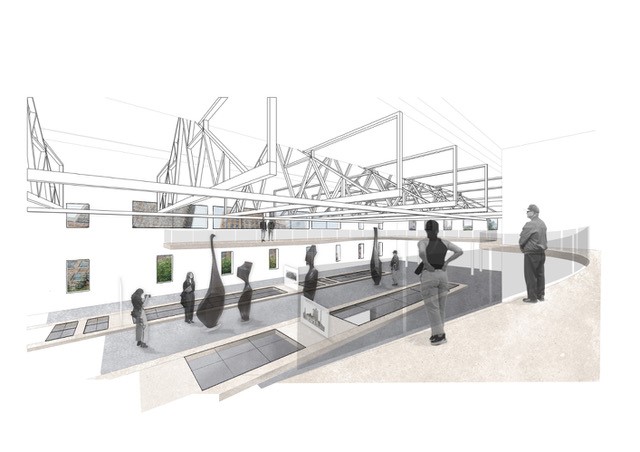
“The six proposals are absolutely amazing, impressive, creative and inspiring,” said Fortin. “The students enjoyed the project even though it was very complex and challenging. They really liked the fact that they were dealing with members of the board—a real client—who were present for all three phases of the project. They provided feedback which helped the students improve their design.”
Some of the design challenges the students faced with this space included: acknowledging that the property is on traditional and unceded territories of the Algonquin nation; adapting an abandoned industrial complex into a functional museum building; demonstrating a commitment to sustainability; showcasing local indigenous materials in all aspects of the design; considering relevant building codes including universal accessibility; addressing eight buildings on a strategic site along the Chaudière Falls of the Ottawa river and a busy urban intersection; and protecting the heritage characters of the buildings, which are designated as historical resources by the Québec Government.
“As for all the students, we would like to thank each and everyone of them for their dedication, their creativity and the enormous amount of time given to this semester’s work. I had the opportunity to see each month since January the thinking process, the struggle and the challenges associated with such a demanding request to adapt a complex industrial site to a cultural institution,” said Jean-Marc Blais, president of the Outaouais Regional Museum, in a press release.
An exhibition from July 29 to August 27 at La Maison Fairview in Gatineau will showcase the six student proposals.
La Maison Fairview
100 Rue Gamelin,
Gatineau, QC J8Y 1V9
From 10 a.m. to 5 p.m., Wednesday to Sunday (except Friday from 12 p.m. to 8 p.m.)
More information on the six proposals can be found below.
Intertwine
By Cloé Beaudry, Jemma Johnson, and Kayla Wallace
Our project focuses on the idea of intertwining. To intertwine means to unite with another, to be mutually involved, and to be closely connected. This concept is rooted in the Outaouais Regional Museums Mission which focuses on bringing together the region’s history and culture into a place where it can be celebrated, and community members can identify with it and connect with each other. The idea also stems from the condition of the E.B Eddy buildings, which call for the intertwining of old and new fabric.
Our design and conservation philosophies also intertwine. The design focuses on the relationships and crossroads created by the regions overlapping tangible and intangible histories. Our conservation approach similarly aims to integrate the existing tangible evidence with the new additions alluding to the intangible. The forms of these are organic further drawing from the concept of intertwine which can also mean to twist, or to curl around. The organic forms come full circle in reflecting the Regional Museum in their association with indigenous communities and the natural movement of people.
Outflow
By Isabella Cole, Annika Landmark, and Ailsa MacDonald
Our adaptive re-use of the former E.B. Eddy Industrial Complex into the Outaouais Regional
Museum is titled Outflow : A Reflective Horizon Where Streamlines Converge. “Only upon reflecting on
the ripples of the past, can the water become still enough to speak, for what is lost in evolution always
seems to flow back in time”. Water has figuratively and metaphorically sculpted the cultural importance
of the E.B Eddy site over time. As it is the force that binds us to the landscape and each other all of our
design decisions were influenced by our parti of flow. The contrast of the flowy walls on the interior of
the museum spaces will further draw people’s attention to the rigidity of the industrial buildings. The
sound of water beginning on the exterior of the building ties the thematic core of the architecture to the
function of the sustainable rain harvesting system. Ramps throughout the interior of the complex
emphasize the feeling of water flowing through the site as it once did. In order to minimize altering the
industrial scale of the interior spaces, the main exhibition spaces were placed in the heritage designated
buildings with the most floor space. The contemporary barrel roof, supported by the new structure behind
the stone masonry, pays homage to a singular barrel roof structure that was previously there. The breaks
in the three tiered roof create dynamic lighting conditions, and the new glass structure in place of building
5 allows the ramps to be seen from the outside further emphasizing reflectivity and flow. The landscape
integrates the building complex to the existing park with embedded narrow streams of water guiding
pedestrians and bikes along the outdoor corridor. Our design aims to create a gathering place where the
community can feel the presence of the diverse story of the site through the symbol of water.
Intersection
By Brooke Hewitt, Natalie Murdoch, and Amanda Soo
The theme of intersection led the design and conservation philosophy for this adaptive reuse project. The parti articulates our intention to manipulate the existing buildings as a medium to facilitate connections between dichotomies (urban/nature; learning/teaching; new/old; colonial/indigenous) that otherwise would have no space to intersect. Our conservation philosophy for this adaptive reuse project aims to introduce new functions to the existing structures to ensure that the site’s heritage values are not lost or diminished, and as a result, have the opportunity to continue adapting to the ever-growing community. With this in mind, the condition assessment performed in “Phase A: Understanding” brought us insight into the lack of structural integrity found in areas of Building 1, 2, 3, and the entirety of Building 5. Where it is not structurally feasible to preserve the existing building materials, the materials shall be reconceptualized into the new design. Hence, within the scope of this challenge, our design philosophy seeks to create opportunities in these spaces that are no longer viable.
There are four key components in our design that speak to these moments of intersection: the commuter’s route, community program space, educational spaces, and landscaping. The commuter’s route is positioned to cut through the unsalvageable portions of the masonry between Building 1 and 2. This cut-out was to provide an alternative path to the unsafe pedestrian/cyclist corner on Alexandre-Tache Blvd. and Eddy St.; adjacent to the complex. The community program space in Building 2’s atrium and outdoor space between Building 2 and 8 are shaped by the seasons to host events such as farmer’s markets, festivals, and local business showcases. The educational spaces are positioned where public and private can intersect and learn from one another. The landscaping is meant to be an extension of the buildings, creating a connection between the site’s context, its community, and nature.
Converging Narratives
By Marlo Fabella, Isabel Sales, and Slade Solomon
To converge is, by definition, to meet at a point. The project aims to introduce a dialogue between different groups while promoting the notion of acknowledgment of “the Other” moving forward through form, circulation and views. “Converging Narratives” highlights these dialogues and aims to bring to light voices that have been unheard.
The E.B. Eddy Complex is situated in a diverse, yet tension-filled cultural landscape, important to the Algonquin Anishinaabe as a site of significant cultural associations, and settlers that later used the site for the timber trade and hydro-electric power during the Industrial Revolution.
The proposed adaptive reuse evaluates seven buildings as part of the E.B. Eddy Complex, some of which are designated historic monuments under the Cultural Property Act administered by the Québec Ministry of Culture. Our intervention applies the Standards and Guidelines of the Conservation of Historic Places in Canada, through phases of understanding, planning and intervening, with special consideration to Standards 4 and 8, and Standards 10, 11, and 12 which are standards relating to rehabilitation. The complex is currently part of the Zibi Masterplan; a redevelopment based on the One Planet Sustainability framework.
Conservation philosophies were applied according conditions and opportunities. Found in a deteriorating condition, the intervention of Building 1 applies an approach of anti-restoration, prompting a new dialogue created by the
juxtaposition of the building in ruin with the site. Building 2 would apply an encased intervention, which speaks to the idea of layering history to represent narratives within the physical and metaphorical contexts. In this space, layers of history are seen through the basement reserves, the exhibition space, and the mezzanine. Large windows showing the surrounding buildings and the water are obstructed by other visitors – a view to frame the future and the presence of the “Other” within it.
Miikana de Liaison
By Rebecca Hill-Lamoureux, Hanna Jenkins, and Johnson Luu
Miikana Di Liaison is a conservation project based on the E.B. Eddy Development by ZIBI. Our project stems from the site’s physical past to its intangible future. Originally the site was made up of complex bridges that crossed the waterway the site was built atop. Bridges continued to be a theme throughout the site as the smaller bridges disappeared, larger ones appeared in their place, bridging the paths together as well as the site. Even now it is just one big bridge atop an underground river.
Now the idea of bridging continues both on the site and beyond. The theme of bridging paths goes on in hopes to reconnect the different communities of the region. Since the site is in such a prime location between the Indigenous, French, English and more, it is important we continue to bridge these communities to the site and to each other, giving a place of renewal, knowledge and entertainment.
Vision
Our vision for Miikana de Liaison is to bridge the buildings to the community, bridge the history to the people, and bridge the urban to the natural.
Statement
We will achieve our vision architecturally by following our philosophies in order to have a cohesive design that is environmentally considerate. While bridging our design to the site and the community’s heritage, we will incorporate interpretive materials, symbols and spaces within our museum.

Niibidoon (Weave)
By Mais Joudeh, Arvin Jowkar, and Morwarid Safa
Our fundamental goal was to design a monument that pays honor to the Indigenous cultures and historic events that transpired at the site, assuring their acknowledgment and preservation for current and future generations. We hoped to do this by incorporating concrete aspects from the past into the present industrial colonial complex, therefore creating a meaningful link between historical and contemporary situations. Our team created a conceptual design that was driven by both the parti diagram and the project’s broader objective.
We took a conscious choice to build a bridge that would serve as a symbolic embodiment of our proposal in order to successfully combine the varied physical characteristics of the Eddy Complex, including the colonial region and the old match factory. The bridge’s design was greatly inspired by the architectural features of the tepee tents historically used by the Ojibwe indigenous people, who were the area’s original occupants. We integrated the tepee tent design into numerous components of the site, such as railings, windows, seats, flooring patterns, and even the landscape, drawing inspiration from this cultural history. We want to effortlessly intertwine every historical period that the Eddy Complex has experienced by using this design element throughout the project.
Our goal was to produce a visually unified and harmonious experience that underlines the cultural value of the place while also bridging the gap between the past and the present. We wanted to highlight and honor the Indigenous legacy by using the tepee tent design in both practical and aesthetic features, developing a profound understanding for the Eddy Complex’s history and variety. Our initiative aims to act as a living monument, conserving Indigenous traditions and events while encouraging cultural understanding, reconciliation, and a revitalized sense of identity for the place. The incorporation of physical components from many eras and cultures inside the complex illustrates our commitment to understanding and honoring the area’s rich legacy in a meaningful and inclusive way.

